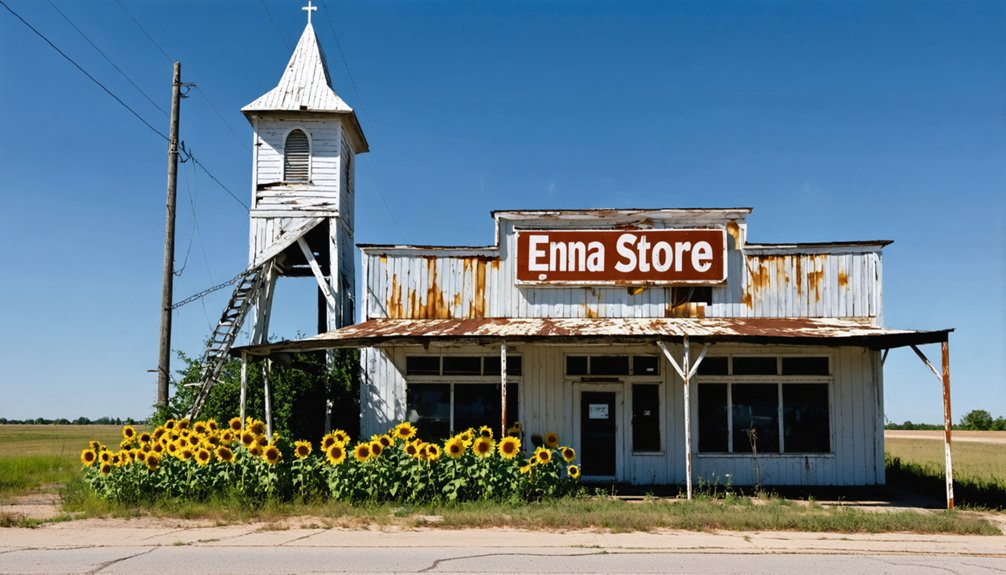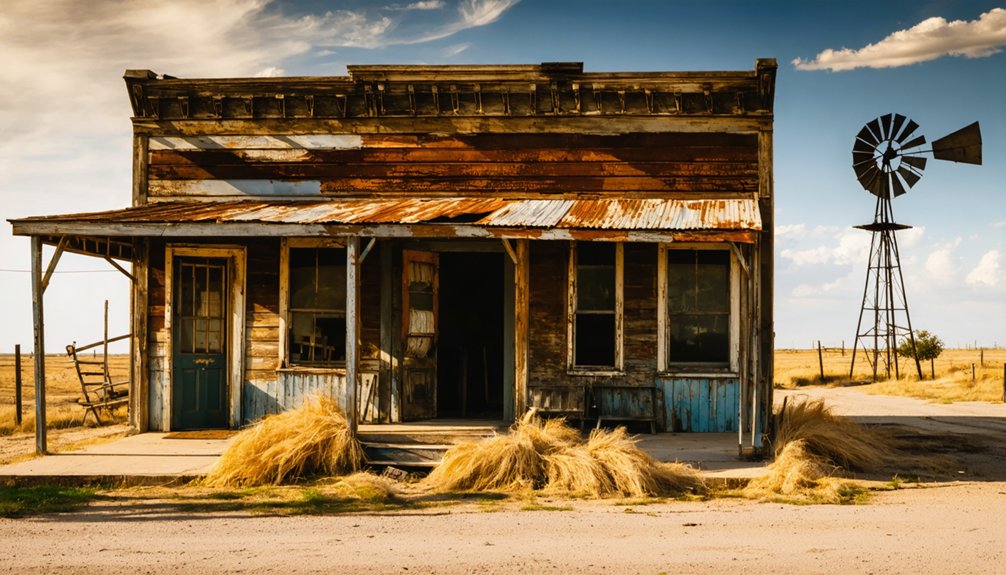You’ll find Etna’s weathered remains in Smith County, Texas, where post-Civil War immigrants from the Old South built a thriving farming settlement. By the early 1880s, the town boasted a district school, church, gristmill, and various stores. But when the Kansas and Gulf Short Line Railroad bypassed Etna for nearby Bullard in 1884, the town’s fate was sealed. The story of Etna’s transformation from bustling community to ghost town holds fascinating twists and turns.
Key Takeaways
- Etna was a post-Civil War settlement in Texas that became a ghost town after being bypassed by the Kansas and Gulf Short Line Railroad.
- The town initially prospered with a district school, church, gristmill, and stores before its decline began in the early 1880s.
- Residents abandoned Etna for nearby Bullard when the railroad built a depot there in 1884, leading to systematic business migration.
- The closure of Etna’s post office in 1883 marked a critical turning point in the town’s decline toward ghost town status.
- The town’s transformation into a ghost town was complete by 1900, leaving behind a legacy in Smith County’s historical narrative.
The Rise and Fall of a Frontier Settlement
While many frontier settlements flourished with the arrival of railroads in late 19th century Texas, Etna’s story took a different turn.
You’ll find that this settlement, founded by post-Civil War immigrants from the Old South, initially thrived despite frontier challenges. By the early 1880s, they’d built a promising community with a district school, church, gristmill, and various stores.
Post-Civil War settlers built a thriving frontier community complete with schools, churches, and commerce despite the harsh Texas wilderness.
But when the Kansas and Gulf Short Line Railroad bypassed Etna in favor of nearby Bullard, the town’s fate was sealed. The pattern mirrored what happened to Texana’s decline when railroads bypassed it. Economic opportunities dried up as businesses and residents followed the rail line to Bullard. Like the powerful Mount Etna volcano in Sicily, this Texas town would leave an indelible mark on the landscape, though for very different reasons.
Within two decades, Etna’s transformation from a bustling frontier town to a ghost town was complete. By 1900, even the post office that had served since 1867 was long gone.
Life in Early Etna
The daily rhythms of life in early Etna painted a picture of determined frontier folk making their way in East Texas. You’d have found a close-knit community of Anglo-American settlers, their lives centered around pioneer agriculture and ranching culture.
Family farms dotted the landscape, while local ranchers wielded enough influence to shape the identity of nearby settlements. Cotton and sugarcane became vital crops as the area developed into a plantation economy. Without railroad access, you’d have relied on basic roads to reach neighboring towns for supplies and trade.
Your social life would’ve revolved around community gatherings, church meetings, and helping neighbors with their harvests. The post office served as an essential lifeline until 1883, but you’d have faced typical frontier challenges – from weather extremes to supply shortages. Community contributions helped preserve stories of these early Texas settlers.
Most settlers eventually moved to nearby Bullard, drawn by better opportunities and railroad connections.
Post Office Closure and Community Decline
You’ll find that Etna’s post office closure in 2021 marked a turning point for the community, disrupting crucial mail services and severing communication lifelines that had kept residents connected for generations.
While the facility reopened in early 2024 after a two-year hiatus, it returned with severely limited services and reduced hours that couldn’t match its former role as a community hub.
Rep. Jared Golden made the official announcement about the post office finally reopening to serve local residents once again.
The loss of full postal services accelerated Etna’s decline, as both current residents and potential newcomers faced increased isolation and diminished access to essential mail services, pushing more folks to seek opportunities elsewhere.
Like many other suspended post offices across America, Etna’s facility joined the ranks of over 400 unresolved suspensions that have plagued rural communities nationwide.
Mail Service Disruption Impact
After Etna’s post office closed in 1883, the town’s decline accelerated at an alarming pace.
You’d have seen the immediate impact as mail service disruptions affected every aspect of daily life. Local businesses couldn’t reliably send orders, receive payments, or maintain regular contact with suppliers. If you lived in Etna then, you’d have had to trek to Bullard just to mail a letter or pick up a package. Understanding how post offices shaped communities, researchers now use discontinued post office records to track the historical evolution of towns like Etna.
The economic impact hit hard and fast. Without postal services, merchants struggled to keep their shelves stocked, and customers drifted away. You couldn’t get your newspaper delivered on time, and important notices often arrived late. Similar to what happened during Hurricane Harvey, entire communities found themselves cut off from vital postal services.
The isolation forced many folks to move to better-connected towns, leaving Etna’s remaining residents with fewer neighbors and diminishing prospects for recovery.
Community Communication Breakdown
While Etna’s post office once served as the town’s communication hub, its closure in 1883 shattered the community’s social fabric.
You can trace the town’s rapid decline through the breakdown of essential communication networks that once kept neighbors connected and businesses thriving.
Here’s how the post office closure fractured Etna’s social cohesion:
- Residents lost their central gathering spot for exchanging news and maintaining relationships.
- Local businesses couldn’t reliably correspond with suppliers and customers.
- Emergency information and important announcements became harder to distribute.
- Government communications and legal notices failed to reach community members efficiently.
The ripple effects were devastating – as communication broke down, folks started moving to nearby Bullard, taking their businesses with them.
Without its post office, Etna’s sense of community slowly faded into memory.
Unlike Etna’s decline, the town of Edna thrived after establishing its post office in 1886, demonstrating how crucial postal services were to a community’s survival.
Population Migration Acceleration
Once Etna’s post office closed its doors in 2021, the town’s population decline shifted into high gear.
You’ll find that outmigration trends accelerated as families sought communities with reliable postal services, particularly in nearby Edna where basic amenities remained intact.
The demographic shifts hit harder than expected – younger folks left first, seeking better opportunities, while older residents struggled with increased transportation burdens to access essential services.
Many residents relocated to 603 Rose Street, where the Edna Post Office provided dependable postal services.
The ripple effects touched every corner of town life.
Without a post office, local businesses couldn’t operate efficiently, property values dropped, and tax revenues dwindled.
The empty storefronts and quiet streets you’ll see today tell the story of how one service loss triggered a chain reaction, pushing more residents to relocate and weakening the town’s economic foundation.
Migration to Bullard and Population Shifts

You’ll find that Etna’s decline picked up speed in the early 1880s as businesses and residents moved to nearby Bullard, where John and Emma Bullard had settled a decade earlier.
When the Kansas and Gulf Short Line Railroad built its depot in Bullard in 1884, the trickle of migration turned into a steady flow, with merchants setting up new shops near the tracks.
The final blow to Etna came when its post office closed in 1883, while Bullard’s population swelled to 200 by 1890, cementing its position as the area’s new commercial hub.
Business Relocation Timeline
After the Kansas and Gulf Short Line Railroad bypassed Etna in the mid-1880s, local businesses began a systematic migration to the nearby town of Bullard.
The shifting business dynamics meant you’d see major changes in both towns as economic incentives drew merchants toward railroad connectivity.
Here’s how the exodus unfolded:
- In 1883, Etna’s post office shut down, marking the first major business departure.
- By the mid-1880s, dry goods stores and blacksmiths relocated their operations.
- The late 1880s saw most remaining merchants abandon Etna for Bullard.
- By 1900, you’d find Etna completely deserted, officially becoming a ghost town.
This mass exodus transformed Bullard into a bustling commercial center while Etna’s once-thriving marketplace fell silent, highlighting how critical railroad access was to a town’s survival.
Population Movement Patterns
While the railroad’s arrival drove Etna’s decline, it sparked a fascinating population shift that reshaped the region’s demographics.
You’ll find that most of Etna’s original settlers, who’d come from Southern states like Tennessee and Mississippi, gradually moved toward the growing town of Bullard, about 30 miles northwest of Rusk.
This migration pattern wasn’t unique – it’s part of broader rural depopulation trends you’ll see across Texas.
As smaller settlements lost their appeal, folks naturally gravitated to places like Bullard that offered better amenities, schools, and economic opportunities.
Population trends show that Bullard’s now become a major draw for new residents, especially those seeking suburban comfort near Tyler’s economic hub.
The town’s rising home values and expanding residential areas tell the story of this continuing transformation.
Legacy in Smith County History
Despite its complete disappearance from the landscape, Etna’s transformation into a ghost town has left an indelible mark on Smith County’s historical narrative.
You’ll find Etna’s heritage woven into the fabric of regional development, offering valuable lessons about community survival and adaptation.
Here’s what makes Etna’s ghost town narrative significant in Smith County’s history:
- It demonstrates how post-Civil War transportation shifts could make or break a town’s future.
- The mass exodus to Bullard shaped that town’s growth and prosperity.
- It serves as a prime example of how Texas settlements adapted to changing economic pressures.
- The town’s story remains preserved in historical archives, documenting the evolution of rural communities.
These patterns of boom and bust continue to influence modern understanding of settlement dynamics in East Texas.
Preservation Efforts and Historical Significance

Throughout the past several decades, dedicated preservation groups have worked tirelessly to protect and document Etna’s remaining historical legacy.
You’ll find that preservation challenges include unclear property titles and the absence of basic utilities, making restoration particularly complex. Like many Texas ghost towns, Etna’s story mirrors the pattern of decline marked by its post office closure in 1883.
Community engagement has become essential to keeping Etna’s history alive. You can see this through educational outreach programs that bring school groups to the site, helping connect today’s residents with their ancestral roots.
Educational programs and community outreach preserve Etna’s legacy, bridging the gap between past generations and current residents.
While the town lacks formal infrastructure, volunteer efforts focus on maintaining historic structures and collecting oral histories. Local missions in Williamson County continue emphasizing the protection of these historic resources for both educational value and economic potential.
Frequently Asked Questions
What Indigenous Tribes Originally Inhabited the Area Before Etna Was Established?
You’ll find Native American tribes like the Karankawa, Tonkawa, and Comanche called this area home. They held cultural significance through their hunting grounds, trading routes, and spiritual connections to the land.
Are There Any Remaining Structures or Ruins Visible at Etna’s Location?
You won’t find any confirmed remaining structures or visible ruins at the location today. Like many abandoned Texas ghost towns, the site’s likely reverted to pastureland with few traces left.
What Was the Peak Population of Etna During Its Most Prosperous Period?
Like a wildflower that blooms briefly, you’ll find that Etna’s peak population was likely between 100-200 folks before railroad bypasses triggered its population decline into a ghost town status.
Did Any Notable Historical Figures or Events Originate From Etna?
You won’t find any notable residents or historical significance coming from Etna. The town’s short-lived existence and quick decline by 1883 didn’t allow time for major figures or events to emerge.
What Natural Resources or Agricultural Products Were Primarily Produced in Etna?
Peaceful pioneer production likely included cotton crops, corn, and cattle raising, but you won’t find detailed records of resource extraction. Like many small Texas settlements, they’d have farmed for basic survival.
References
- https://www.tshaonline.org/handbook/entries/etna-tx
- https://texashighways.com/culture/arts-entertainment/speaking-of-texas-texana/
- https://en.wikipedia.org/wiki/Texana
- https://kids.kiddle.co/Etna
- https://exploretexas.com/blog/history-of-edna-texas/
- https://www.texasescapes.com/TexasGulfCoastTowns/Texana-Texas.htm
- https://www.tshaonline.org/handbook/entries/texana-tx
- https://www.texasescapes.com/TexasGulfCoastTowns/EdnaTexas.htm
- https://texastimetravel.com/directory/texana-museum/
- https://en.wikipedia.org/wiki/Etna



